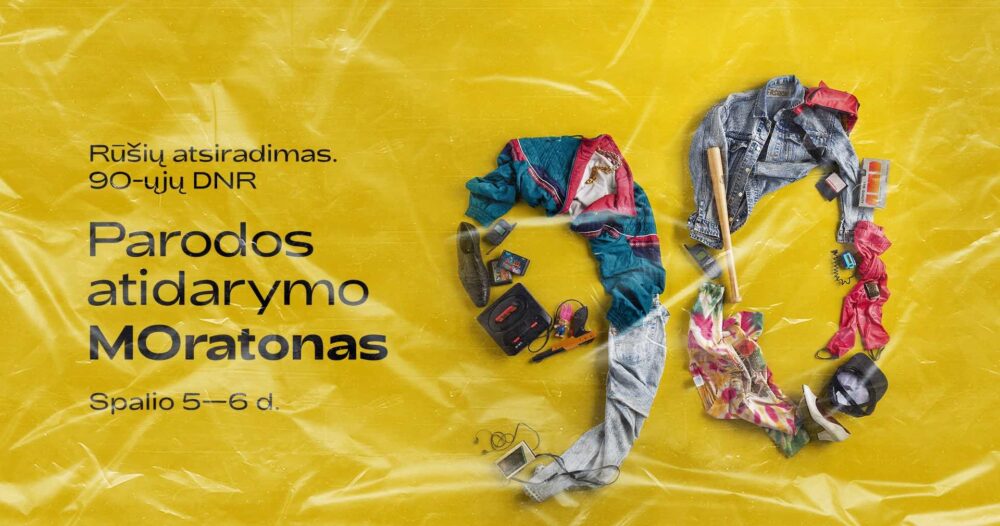MO invites to discover a new exhibition “The Origin of Species: 1990s DNA”

MO Museum invites to remember your own stories and discover new exhibition "The Origin of Species: 1990s DNA"
The last decade of the previous century, which also happened to be the first decade of our restored state, is the most recent history of independent Lithuania. Many of us have experienced it while being at different stages of our lives. What were we like then? Starting October 5, MO Museum is introducing the exhibition, full of memories and most diverse moods – “The Origin of Species: 1990s DNA”.
The exhibition, featuring artworks, objects, stories collected from people and new installations introduces the history of Lithuania’s 90s – a decade of great breakthroughs and changes. This is the beginning of new history, and not only of our country but ourselves too: people’s situations and statuses have radically changed, while new opportunities and risks emerged.
Remembering stories
“Having started our exhibition activities with the statement that all art is about us, at all MO exhibitions we are looking for links between art and life. The new MO exhibition accomplishes this statement in every possible way. By this exhibition, we are willing to encourage people to remember themselves – who we were, are or can be,” says Milda Ivanauskienė, Director at MO Museum.
According to one of the exhibition curators Vaidas Jauniškis, this exhibition could refer to the title of the first MO exhibition “All art is about us” to the modified “All art is about us, survivors”. “Or a subheading could be added: “from Gariūnai to Akropolis”. “From Gariūnai, which was a sporadically born phenomenon where everyone was trying to survive and find their own place, to Akropolis as a structure that asserted order”.
The exhibition avoids direct political narrative, instead, the perspective of people’s daily lives is introduced. The curators attempted to detect phenomena specific to that period and illustrate them not only with everyday objects but also with artworks commenting on the exhibition theme.
“Among the many phenomena of that period, exhibition visitors will be able to recognise and remember themselves in the 90s as well as rediscover that decade,” says Miglė Survilaitė, curator of the exhibition. She also named a couple of works that visitors will be able to see at the exhibition: for example, an Olympic costume, created by Japanese designer Issey Miyake, that was worn by Lithuanians who attended the Barcelona Olympic Games 1992, as well as kiosks which were so popular at the time and which are reflected in the work by artist Liudas Parulskis.
Wide public also took part in exhibition development
The public was also invited to take part in the exhibition creation process – items donated or lent by people (clippings, notebooks, clothes, various equipment, etc.) are also on display. The curators’ team invited everyone to contribute and have been collecting a variety of items for half a year, and, as it turned out, not all of them were that easy to find.
The abundance of collected, borrowed and donated items in a way reflects the multi-layered nature of the period – the exhibition combines art, culture and the everyday life of that time. Alongside music, fashion, the market economy as well as that of Gariūnai, raging mafia and pop culture, pieces from the MO collection will also find their place: films, installations, performances and paintings.
Diverse team of curators
A very diverse team has been put together particularly for this exhibition. It includes cultural analyst Vaidas Jauniškis, writer and literary scientist Rimantas Kmita, cultural historians Aurimas Švedas and Tomas Vaiseta, curator of MO Museum Miglė Survilaitė, nostalgia researcher Mantas Pelakauskas, scenographer-architect Renata Valčik and architect Joris Šykovas.
According to one of the exhibition curators Miglė Survilaitė, whilst forming such a team they expected to find a new angle and different approach. “The composition of the team already indicates that this will not be an exhibition of pure art, as we were not attempting to analyse the art of that period but rather wanted to talk about culture in the broad sense. We call the exhibition experimental because works of art, everyday objects collected from people and the work by scenographer Renata Valčik are being combined. When we were preparing the exhibition, we had many discussions and were sharing memories of what we were like in the 90s. So we are presenting our visitors with the conclusions of our general discussions which were visually put together by the exhibition scenographer,” Survilaitė says.
The exhibition architecture created by R. Valčik is more like scenography than architecture. Each chapter or phenomenon had to find a symbol – an installation. These installations are a work of art that complements and structures the entire exhibition.
Exhibition “Origin of Species: 1990s DNA” will run from October 5. Over the weekend the exhibition opening MOrathon will take place.